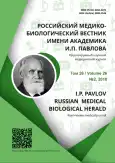Three-dimensional reconstruction of substantia nigra pars compacta of human brain
- Authors: Voronkov D.N.1, Salkov V.N.1, Khudoerkov R.M.1
-
Affiliations:
- Research Center of Neurology
- Issue: Vol 26, No 2 (2018)
- Pages: 175-183
- Section: Original study
- URL: https://journals.rcsi.science/pavlovj/article/view/9090
- DOI: https://doi.org/10.23888/PAVLOVJ2018262175-183
- ID: 9090
Cite item
Abstract
Background. Up to the moment there is no universally accepted scheme of spatial organization of the groups of neurons of substantia nigra pars compacta of the human midbrain. A detailed study of the architectonics of this structure is necessary for pathomorphological analysis of agerelated changes in the nervous tissue and the associated neurodegenerative diseases with selective death of dopamine neurons.
Aim. To clarify the peculiarities of the morphochemical organization of the substantia nigra (SN) of a human brain and to create a threedimensional model of pars compacta.
Materials and Methods. Threedimensional reconstruction of substantia nigra pars compacta was performed on the brain autopsy material of individuals without neurological pathology (n=10, between 52 to 84 years of age) using a method of computed morphometry. Sections of the midbrain were stained by Nissl method and by an immunohistochemical method for localization of tyrosine hydroxylase – a marker of dopamine.
Results. In the SN pars compacta accumulations of neurons were identified in the form of 9 bands oriented in the rostrocaudal direction and including four areas: medial, lateral, dorsal and ventral. Morphometric analysis detected significant differences in the density of neurons and in expression of tyrosine hydroxylase between the areas of SN.
Conclusion. A model of cellular organization of SN pars compacta proposed by us on the basis of threedimensional reconstruction is characterized by a high degree of detalization as compared to similar works, and shows expressed spatial differentiation of the groups of neurons of SN which should be taken into consideration in pathomorphological examinations.
Full Text
##article.viewOnOriginalSite##About the authors
Dmitriy N. Voronkov
Research Center of Neurology
Author for correspondence.
Email: neurolab@yandex.ru
ORCID iD: 0000-0001-5222-5322
SPIN-code: 1576-8871
MD, PhD, Senior Researcher of Laboratory of Functional Morphochemistry of the Department of Study of Brain
Russian Federation, MoscowVladimir N. Salkov
Research Center of Neurology
Email: neurolab@yandex.ru
ORCID iD: 0000-0002-1580-0380
SPIN-code: 1459-9812
MD, Grand PhD, Senior Researcher of Laboratory of Functional Morphochemistry of the Department of Study of Brain
Russian Federation, MoscowRudolf M. Khudoerkov
Research Center of Neurology
Email: neurolab@yandex.ru
ORCID iD: 0000-0002-6951-3918
SPIN-code: 4647-8405
MD, Grand PhD, Head of Laboratory of Functional Morphochemistry of the Department of Study of Brain
Russian Federation, MoscowReferences
- Rudow G, O'Brien R, Savonenko AV, et al. Morphometry of the human substantia nigra in ageing and Parkinson's disease. Acta Neuropathol. 2008;115(4):46170. doi: 10.1007/s00 40100803528
- Illarioshkin SN, Vlasenko AG, Fedotova EYu. Current means for identifying the latent stage of a neurodegenerative process. Annals of clinical and experimental neurology. 2013;2:3950. (In Russ).
- Hassler R. Zur Normalanatomie der Substantia nigra. Versuch einer architektonischen Gliederung. J Psychol Neurol. 1937;48:155. (In German).
- Hirsch E, Graybiel AM, Agid YA. Melanized dopaminergic neurons are differentially susceptible to degeneration in Parkinson’s disease. Nature. 1988;334:3458.
- Damier P, Hirsch EС, Agid Y, et al. The substantia nigra of the human brain. Patterns of loss of dopaminecontaining neurons in Parkinson's disease. Brain. 1999;122:143748. doi: 10.1093/brain/122.8.1437
- Ross GW, Petrovitch H, Abbott RD, et al. Parkinsonian signs and substantia nigra neuron density in decendents elders without PD. Ann Neurol. 2004;56:5329. doi: 10.1002/ana.20226
- Gaykema RP, Zaborszky L. Direct catecholaminergiccholinergic interactions in the basal forebrain. Substantia nigra – ventral tegmental area projections to cholinergic neurons. J Comp Neurol. 1996;374(4):55577. doi:10.1002/ (SICI)10969861(19961028)374:4<555::AIDCNE6>3.0.CO;20
- Fu Y, Yuan Y, Halliday G, et al. A cytoarchitectonic and chemoarchitectonic analysis of the dopamine cell groups in the substantia nigra, ventral tegmental area, and retrorubral field in the mouse. Brain Struct Funct. 2012;217(2):591612. doi: 10.1007/s0042901103492
- Andrey P, Maurin Y. FreeD: an integrated environment for threedimensional reconstruction from serial sections. Journal of Neuroscience Methods. 2005;145:23344. doi:10.1016/ j.jneumeth.2005.01.006
- Khudoerkov RM. Metody komp'yuternoj morphometrii v nejromorphologii. Moscow: NCN; 2014. (In Russ).
- Khudoerkov RM, Voronkov DN, Dikalova YV. Quantitative morphochemical characterization of the neurons in substantia nigra of rat brain and its volume reconstruction. Bull Exp Biol Med. 2014;156(6):8614. (In Russ). doi:10.1007/ s1051701424708
- Joel D, Weiner I. The connections of the dopaminergic system with the striatum in rats and primates: an analysis with respect to the functional and compartmental organization of the striatum. Neuroscience. 2000;96(3):45174. doi: 10.1016/S03064522(99)005758
- Fearnley JM, Lees AJ. Ageing and Parkinson’s disease: substantia nigra regional selectivity. Brain. 1991;114:2283301. doi: 10.1093/brain/ 114.5.2283
- Damier P, Hirsch EС, Agid Y, et al. The substantia nigra of the human brain. Nigrosomes and nigral matrix, a compartmental organization based on calbindin D28k immunogistochemistry. Brain. 1999;122:142136. doi:10. 1093/brain/122.8.1421
- Wakabayashi K, Mori F, Takahashi H. Progression patterns of neuronal loss and Lewy body pathology in the substantia nigra in Parkinson’s disease. Parkinsonism and Related Disorders. 2006;96:1338. doi: 10.1016/j.parkreldis.2006.05.028
- Brichta L, Greengard P. Molecular determinants of selective dopaminergic vulnerability in Parkinson’s disease: an update. Front Neuroanat. 2014;8:152. doi: 10.3389/fnana.2014.00152
- Fu Y, Paxinos G, Watson C, et al. The substantia nigra and ventral tegmental dopaminergic neurons from development to degeneration. Journal of Chemical Neuroanatomy. 2016; 76:98107. doi: 10.1016/j.jchemneu.2016.02.001
Supplementary files










